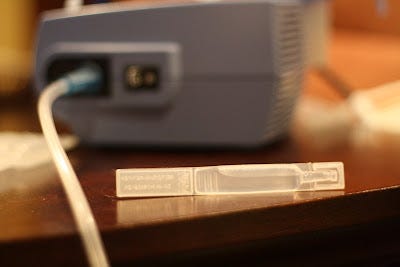Inhaled hypertonic saline for young kids with cystic fibrosis: no benefit? (RCT)

(image: Bennett Gamel blog)
Inhaled hypertonic saline (7% NaCl) increases clearance of mucus by airway cilia, making it an attractive treatment for cystic fibrosis. Hypertonic saline has been a cornerstone of daily therapy for CF ever since a 2006 NEJM randomized trial showed that ~80 adults and kids older than 6 using hypertonic saline for one year had improved lung function and reduced exacerbations compared to ~80 CF patients inhaling placebo (0.9% saline).
Although kids with CF under 6 weren't included in that trial, they are increasingly being given daily inhaled hypertonic saline at CF centers: impairment from cystic fibrosis starts at birth, and it's believed by many CF experts that the sooner therapies can be instituted to slow the inevitable decline of lung function, the better.
Margaret Rosenfeld, Felix Ratjen, Stephanie Davis et al (the ISIS Study Group) report that among children younger than 6, inhaled hypertonic saline did not reduce exacerbations, in their ISIS randomized trial reported in the June 6 JAMA. Inhaled hypertonic saline's effects on lung function were not clearly beneficial either, but may have improved FEV1 slightly.
What They Did
At 30 cystic fibrosis centers in the U.S., 321 children with CF younger than 6 were randomized to receive either 4 mL of 7% inhaled hypertonic saline or 0.9% saline (isotonic placebo) twice daily for 48 weeks. Each dose was immediately preceded by albuterol.
Primary outcome was the rate of pulmonary exacerbations requiring antibiotics, with specified definitional criteria (hypoxia, new infiltrate, etc.)
Pulmonary function testing, weight changes, and safety comprised some of the numerous secondary endpoints.
Adherence was measured by the number of drug vials returned by parents.
What They Found
There was no difference in the rate of pulmonary exacerbations between hypertonic saline and placebo: both were 2.3 per person-year.
Among the raw pulmonary function data, there was no difference betweeen groups. After adjusting for height, weight, sex, age, and baseline lung function, the children receiving inhaled hypertonic saline had a relative 38 mL improvement in forced expiratory volume in one second (FEV1) compared to placebo. (These measurements could only be obtained in about two-thirds of the children; special pulmonary function testing techniques are required.)
What It Means
An editorial by Elliott Dasenbrook wonders whether infant pulmonary function testing is sensitive enough to detect meaningful changes in lung function, and suggests the development of newer, more sensitive endpoints for evaluating new therapies in children this young. It's unclear how the CF treatment community will respond to this trial. While this trial was being conducted, surveys suggested that (in response to the positive findings in older children and adults) the use of inhaled hypertonic saline for infants and young children treated at CF centers rose from 6% to 19%.
Rosenfeld M et al. Inhaled Hypertonic Saline in Infants and Children Younger Than 6 Years With Cystic Fibrosis: The ISIS randomized controlled trial. JAMA 2012;307:2269-2277.


